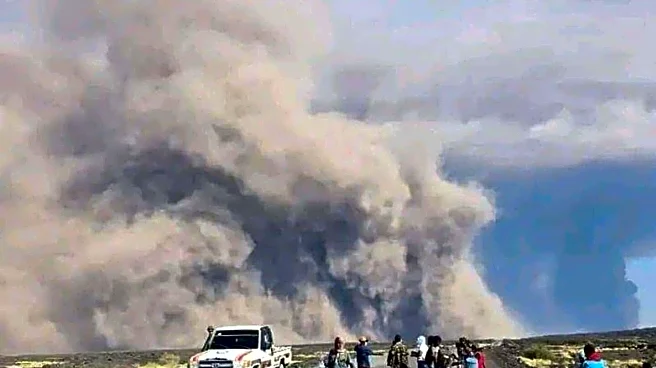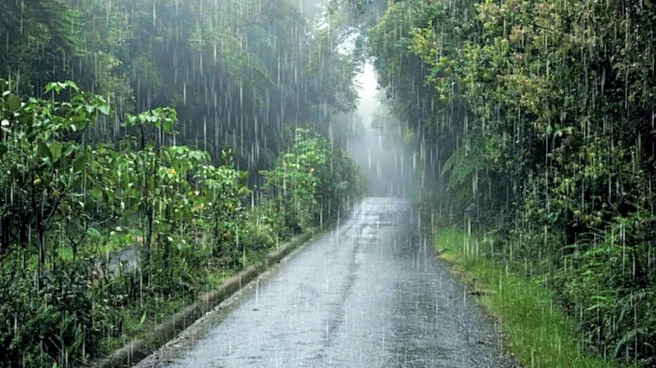New Delhi: An ash cloud from Ethiopia’s Hayli Gubbi volcano reached parts of India on Monday evening. The plume first entered Gujarat from the west and quickly moved across Rajasthan, northwest Maharashtra,
Delhi, Haryana and Punjab by around 10 pm. It is now drifting towards the Himalayas and other northern areas. It has affected flight operations in India. Weather experts warned that skies could look “darker and hazier than usual” and that flights might face delays and longer travel times. In the latest update, the India Meteorological Department said the ash clouds are drifting towards China and will move away from India by 7.30 pm on Tuesday.Authorities watched the movement of the cloud closely as it approached major cities like Delhi and Jaipur. Early signs were spotted near Jamnagar at around 5:30 pm, leading to growing concern through the evening. The ash plume is travelling at a height between 15,000 and 25,000 feet, with some parts rising as high as 45,000 feet. It contains volcanic ash, sulphur dioxide, and tiny particles of glass and rock, reported The Times of India.Also Read: Delhi’s ‘Very Poor’ AQI Gets a Volcanic Twist: Is Ethiopia’s Ash Cloud Making Delhi Pollution Worse?
Areas Most Affected in India
JaipurJamnagarDelhi-NCR Parts of- Haryana, UP, Punjab and Western MaharashtraThe ash cloud spread over large parts of northwest India on Monday night. It passed above Gujarat, Rajasthan, Maharashtra, Delhi-NCR and Punjab. In some places, visibility dropped as the plume travelled eastward. "Ash cloud is about to enter Gujarat (West side) and move towards Rajasthan, northwest Maharashtra, Delhi, Haryana, and Punjab by 10 pm, and later it will impact the Himalayas and other regions," the meteorological service said.
The cloud was moving at a speed of 100–120 km/h and could darken skies and affect flight routes, according to news agency ANI. By late night, Delhi, NCR, Haryana and even parts of Uttar Pradesh saw the sulphur-rich plume passing overhead.Experts said there was little chance of ash falling on the ground in the plains, though residents may notice a sky that looks similar to a dust storm.
Will the Ash Affect Air Quality?
Meteorologists said the ash cloud is too high in the sky to harm air quality at ground level. The ash is mainly at 25,000–45,000 feet, so surface AQI is not expected to worsen.However, sulphur dioxide levels may increase in the Himalayan areas, Nepal, and the Terai belt of Uttar Pradesh, as the cloud brushes against mountain slopes before moving further towards China. People on the ground may see darker, hazier skies, but only a very small number of particles, if any, are expected to settle. Experts advised wearing masks as a precaution, but stressed that the event is happening in the “middle levels of the atmosphere.”
How Did the Ash Travel to India?
The Toulouse Volcanic Ash Advisory Centre (VAAC) reported that the eruption started at around 8:30 am GMT on Sunday. This was the first eruption from the Hayli Gubbi volcano in almost 10,000 years. Thick ash columns rose nearly 14 kilometres into the sky from Ethiopia’s Afar region, close to the Eritrean border.Although the eruption stopped, the VAAC confirmed that a large ash cloud continued to travel towards northern India. The volcano lies along the active Rift Valley, where tectonic plates meet. After rising into the atmosphere, the ash moved across the Red Sea, passed over Yemen and Oman, and then blew eastwards into India and northern Pakistan.

/images/ppid_a911dc6a-image-176404544047063153.webp)

/images/ppid_a911dc6a-image-176404286710753090.webp)
/images/ppid_a911dc6a-image-176403763011891870.webp)
/images/ppid_a911dc6a-image-17640448254938395.webp)








